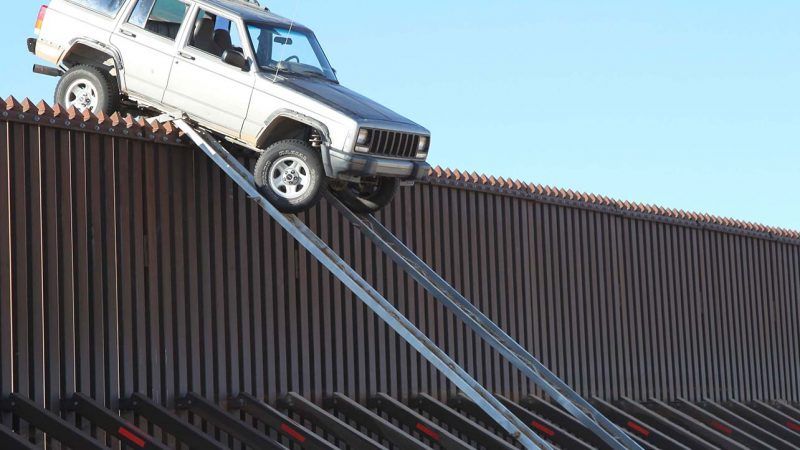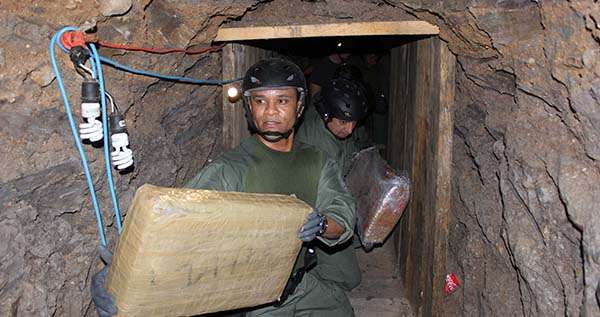Drug Smugglers Have Already Beaten Trump's Wall

During a speech announcing his intention to seek the presidency, Donald Trump stumbled on what would become a signature issue for his campaign: Mexico. "When Mexico sends its people, they're not sending their best," he said. "They're sending people that have lots of problems, and they're bringing those problems with them. They're bringing drugs. They're bringing crime."
The "great, great wall" Trump wants to build isn't just aimed at stopping the people from crossing illegally into the United States; it's also supposed to stop the narcotics. But it isn't going to work.
To be blunt, the U.S. government is not likely to outspend the drug cartels at the border. Even if Trump is willing to put up the $21.6 billion the Department of Homeland Security estimates constructing a barrier would cost, the illegal drug trade is a $350 billion international business, according to the United Nations World Drug Program. A 2014 report from RAND Corp. estimated the American drug market for the four most prevalent illicit drugs—cannabis, heroin, cocaine, and methamphetamines—at $100 billion annually. The profit incentives to find ways over, under, around, or through any border infrastructure are high, and the cartels have more than enough money to spend on R&D.
Drug smugglers are already using a wide range of techniques to move merchandise across the border, and doing so quite successfully. On the low-tech end of the spectrum are so-called drug mules. Immigrants wishing to cross the border and their coyotes, or paid guides, must first pay tribute to the cartel that controls the plaza, or approach to the border. The payment may be in cash, but it often also includes an agreement by the migrants to carry drug loads with them as they cross. This is actually a pretty high-risk import strategy: If the mules are caught, the cartels lose the drugs. But more often than not, the smugglers are using migrants as a decoy to draw the attention of the Border Patrol while they move larger loads across elsewhere.
Current border infrastructure, such as steel mesh fencing, is easy enough to cut through with a Sawzall, and such half-moon gashes are everywhere, especially in places such as San Diego. A 2009 Government Accountability Office report said Congress would have to spend $6.5 billion over 20 years just to repair the existing fencing.
Another low-tech method to foil existing infrastructure involves using catapults to launch bales of drugs over the fence. One such device, discovered in February on the Arizona border, was actually attached to the Mexican side of the fence. Some barriers, such as the four-inch steel tubes cemented vertically into the ground and placed four inches apart that are used in parts of the Arizona desert, can prevent people from crossing but are easy enough pass three-inch packages of heroin through. An actual wall would stop this particular type of small-bore smuggling, but these transactions account for very little of the overall traffic.

Instead, billions of dollars and thousands of tons of drugs are smuggled through authorized ports of entry every year, hidden in compartments in cars, trucks, and railcars. Customs and Border Protection officers use sophisticated X-rays and gamma radiation detectors to find these loads and seize tons of narcotics that way each year. But the very fact that officials are still capturing large shipments—such as the 4,000 pounds of marijuana disguised as limes found last month at a Texas port of entry—on a regular basis means it must still be profitable for the smugglers to attempt it. It's just a cost of doing business to them.
There are high-tech smuggling efforts as well. The preferred method for water-based trafficking has moved from fast boats in the style made famous by Miami Vice in the 1980s, to pangas, or open-outboard boats running up the Pacific coast, after that, to homemade submarines in the last decade, including semi-submersibles that hover just under the surface to keep a low profile. The latter are piloted by one to four very brave souls, since they very often sink before reaching land. Newer efforts involve fully submersible submarines and drug "torpedoes" that are towed beneath a surface vessel far under the water. These can carry as much as 12 tons of narcotics.
And then there are the tunnels. Hundreds have been found running under the U.S.-Mexico border in the last decade. For a million dollars, a cartel can bore a passage complete with ventilation, lighting, and cart rails, and make that money back with just one successful load of heroin or cocaine. Infamous drug lord El Chapo's Sinaloa cartel has been the most effective in history at tunneling.
The cartels have also used manned ultralight aircraft to carry bundles over the border fences. In 2012, the National Geographic series Border Wars captured dramatic footage of an ultralight dumping bundles of marijuana into the United States. Drones can transport high-profit, low-weight drugs such as heroin, as evidenced by a 2015 bust in which two men were arrested retrieving 28 pounds of product after an unmanned device carried it across the border and dropped it along the side of Route 98 in Imperial, California. Although the use of sophisticated aerial surveillance, such as "tethered aerostat" blimps, has decreased these incursions, they do continue.
Submarines, drones, and tunnels are seen as capital investments for the cartels. When one avenue is interdicted, they shift to another, or back to something they previously employed. And if that doesn't work, they can take that same million dollars and use it to bribe a corrupt border official; this strategy could become more common if under Trump the border becomes more fortified.
In short, as long as the demand for drugs remains high, the chances that the U.S. government spending between $12 billion and $20 billion dollars on a wall will significantly diminish the cartels' ability to get their wares into the United States is anything but "yuge."
This article originally appeared in print under the headline "Drug Smugglers Have Already Beaten Trump's Wall."


Show Comments (96)